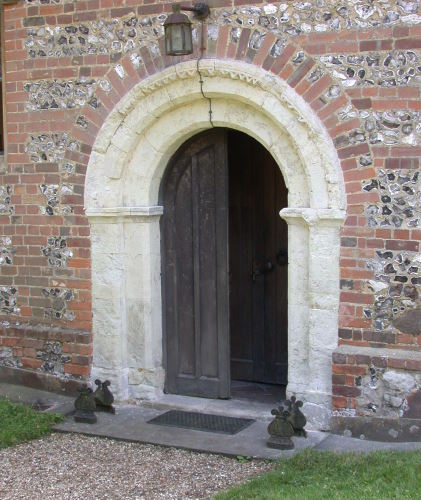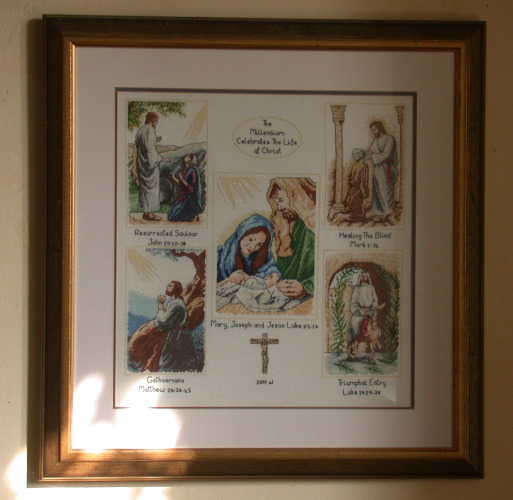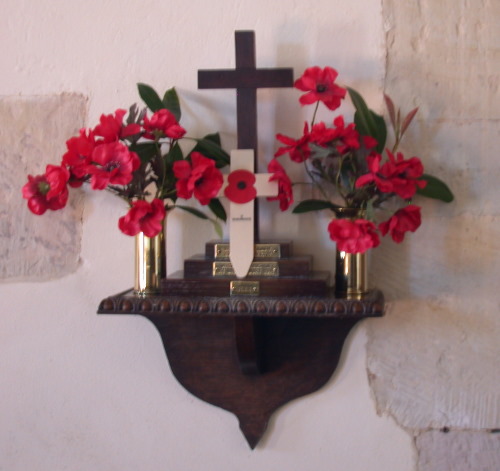St Stephen Up Nately
St Stephen’s dates from around 1200, with 15th and 19th century alterations. It is the only one of the five United Parish churches with box pews, and is a fine example of an ancient village church in simple style over which much care has been taken.
Fuller descriptive notes will be found below.
The church consists of a Chancel 11ft 1in by 7ft 9in, a Nave 36ft by 20ft 3in, a small West Tower 6ft square and a south Vestry. The walls of the Nave belonged to the original 12th century building, but they have been entirely replaced and later windows have been added. The easternmost of the two south-side windows of the Nave is of a 15th century date and has two cinque-foiled lights, each under a square head with a moulded label. The other Nave windows are modern copies set in old jambs.
 At the western end of the north wall, the main doorway is of a late 12th century date. Its jambs and semi-circular arch are of two chamfered orders with a grooved and hollow chamfered abacus and a label enriched with dog-toothed ornament.
At the western end of the north wall, the main doorway is of a late 12th century date. Its jambs and semi-circular arch are of two chamfered orders with a grooved and hollow chamfered abacus and a label enriched with dog-toothed ornament.
The Chancel, the Tower and the Vestry were all built in 1844, when the exterior of the church was refaced with bands of red brick and flint work, with buttresses at the corners. The east window of the Chancel is modern and has three cinque-foiled lights under a four-centred head. The Chancel arch, entirely of late 12th century stone-work, is 4ft 1in in thickness, has square jambs, and the arch is semi-circular with a grooved and hollow chamfered abacus at the springing.
The Tower, built in brick and flint, has a two-light window under a square head (the Vestry window is similar) and has a plain two-light window in each face near the top. Two bells hang in the Tower, one bearing the initials “R.P.” and the date 1716 and the other merely dated 1715.
The walls of the Nave are faced with flint and brick, except the east wall which is plastered flint work. The Vestry is of brick and the Chancel flint and brick.
The Plate, which is never in the church except during Eucharist, consists of a silver chalice and cover-paten of 1681 and a silver flagon of 1788 given in 1833 by James Blatch, D.D., Vicar, and a silver alms plate of 1792 also given by Dr Blatch in 1846. The earliest Registers contain entries from 1695 to 1812.
 A tapestry depicting the Life of Christ was worked in cross stitch by Ladies of the Village.
A tapestry depicting the Life of Christ was worked in cross stitch by Ladies of the Village.
Special Memorials
 On the east wall near to the Vestry is a memorial to Alfred James Clark. He had joined the Army in 1914, two years later his wife received the tragic news of his death. He had been a patient in France when the hospital was bombed with most of the occupants perishing. This memorial when erected was quite unique, for it was only the second such one-man-memorial in the British Isles.
On the east wall near to the Vestry is a memorial to Alfred James Clark. He had joined the Army in 1914, two years later his wife received the tragic news of his death. He had been a patient in France when the hospital was bombed with most of the occupants perishing. This memorial when erected was quite unique, for it was only the second such one-man-memorial in the British Isles.
In 1994 the Gold Altar cloth was found to be in need of renovation. It was decided to re-use as much of the original material as was possible. The cloth had originally been beautifully stitched by hand, but unfortunately most of the back lining fell to bits as it was taken apart. The first thing was removing the Gold Cross which was badly in need of repair. When the cross had been completely removed, an inscription was found written on the back of the cloth.
We cannot find when the Altar Cloth came to the village or where it came from. We have managed to trace most of the men named, where they came from and their war records. However, they came from all parts of the country, from many different regiments and did not all die in one place. So how they came to be named together on an Altar Cloth in our church unfortunately remains a mystery. We are proud to have this memorial, but amazed that the cloth had hung at the Altar for so many years with nobody knowing anything about the inscription. The names of the men from our village who fell in the Second World War have now been added.
We are honoured to have two Commonwealth War Graves to care for in the churchyard:
* Lance Corporal Frank Evans lived at Dell Cottage, Up Nately. He served in The Oxfordshire & Buckinghamshire Light Infantry, Airborne. Whilst on exercises before D Day a live grenade killed L/Cpl Evans and another soldier. He was killed on lst June 1943 aged 23 years.
* Flight Sergeant Alan Woodbridge lived at Crossways, Up Nately. He served in the R.A.F. as a glider pilot. When landing one day another plane crashed on top of his. He was killed on 18th August 1944 aged 23 years.
The other person from the village killed in the Second World War was Ray Brown who lived at Hillside, Heather Lane. He served in The Grenadier Guards and was killed when a bomb hit the barracks in London. He was buried with full Military Honours in Mapledurwell Churchyard.